Essay
reviews history from the 8-19th centuries, to realise that Muslims
did not rule all of India for 800 years. Hindustan (Urdu speaking areas of
Indian Sub-continent) is not India.
Time
and again we hear that Muslims
ruled India for 800 years. R M Sayani in his Presidential address at the 12th session of the Congress held in 1896 said, “Before the advent of the British in India, the Muslims were the rulers of the country. The Hindus were in awe of them. By a stroke of misfortune, the Muslims had to abdicate their position and descend to the level of their Hindu fellow-countrymen.” Vol 10 HCIP Pg. 295 excerpts.
By
reviewing history from the 8-19th centuries, this essay examines if Muslims
did indeed rule India for 800 years.
Reference
books are volumes of History and Culture
of the Indian People (HCIP) published by the Bharatiya Vidya Bhavan. All
credits to publisher and general editor Shri R C Mazumdar. I have only
compiled.
Format
is summary, chronology of key events as per period of HCIP volume, extracts
from volume preface/foreword. Comments in red. Page numbers are of HCIP volume.
In case of any errors, a different view point mail with references.
Summary
This
gives you a snapshot of key dates and comments.
1.
712 A.D. Muslim invasion of Sindh.
2.
About 725 an Arab army, sent to invade North India, met with a setback at the
hands of Nagabhata I of the Pratihara dynasty; another which had entered South
Gujarat was destroyed by Pulakesin A in a battle that took place near Navsari.
3.
1018 Mahmud Ghazni invasion of Mathura, Kannauj.
4.
1018 Rajendra Chola conquered Ceylon.
5. 1033 Ghazni’s nephew Masud was defeated by Raja Suheldev lead warriors. Thereafter, No invasion of India for about 150 years.
6.
1192 Prithviraj Chauhan lost to M Ghori in Second Battle of Tarain.
7.
1000-1300: Freedom-fighter and founder of
Bharatiya Vidya Bhavan Kulapati K M Munshi wrote, “Except within areas in which Turkish armies operated, the India of the age belonged to the heroes of the resistance. Outside this area lay large parts of North India and the whole of the South-in fact 3/4th of the country where India followed its unbroken way of life.” During this period Bakhtyar Khilji suffered disastrous defeat in Assam.
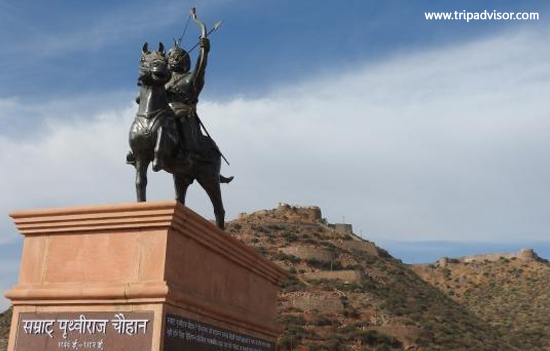 Prithviraj Chauhan Sthal, Ajmer.
Prithviraj Chauhan Sthal, Ajmer.
8.
1300 to 1526: Revival of Hindu power in
South India 1335. Hindu confederacy led by Prolaya Nayaka.
General
Editor Dr R C Mazumdar wrote, “The popular notion that after the conquest of M Ghori, India formed a Muslim Empire under various dynasties is hardly borne out by facts. It was ‘Ala-ud-din Khilji who the first time established Muslim suzerainty over nearly the whole of India. But his actual sovereignty did not extend beyond the Vindhyas, save in the Western Deccan during the last three years of his rule.” Khilji ruled from 1296 to 1316.
9.
1526 to 1707: Dr R C Majumdar wrote, “This is the period during which the Mughuls gradually established their authority over nearly the whole of India.” “Next to the Mughals, the Rajput States in the north, the five Sultanates of the Deccan arising out of the ruins of the Bahmani kingdom, and the Hindu Empire of Vijayanagara played a dominant role in history at the beginning of this period. (1527). The end of this period witnessed the rise of 2 great powers, the Marathas and Sikhs who were destined to play the most prominent role in the 18th century.”
10.
Disintegration of Mughal Empire started after the death of Aurangzeb for e.g.
the rulers of Marwar declared independence.
11.
The 18th century is called the Maratha Century because the Marathas
dominated India.
12.
The British took over from the Marathas, the Mughul ruler in Delhi was a
titular head.
Thus, the only period when the Invaders might claim to have ruled
all of India is from Akbar to Aurangzeb i.e. 1556 to 1707 i.e. a maximum of 151
years.
1556
is when Akbar ascended the throne and 1707 is when Aurangzeb died hence 151
years taken for this period. Note that Babur and Humayun laid the foundation
for Mughul rule so excluded period they ruled. Further, 1526 to 1707 includes
when Vijayanagar Empire existed.
A
possible reason why this myth of Muslims ruled India for 800 years has started is
because for some India is meant to mean Hindustan (Urdu speaking areas of the
Indian Sub-continent), the area which Muslims dominated over. India is bigger
than Hindustan. This 800 year narrative is similar to our obsession with the
Taj when there are better monuments (from an architectural perspective).
 There is more to India than the Taj.
There is more to India than the Taj.
1. Period 320-750 A.D. (Bhavan
volume 3)
This
part covers Arab invasion of Sindh and how Arabs were repulsed elsewhere.
1.
712 A.D. Conquest of Sindh by Muhammad-bin-Qasim.
2. 724-38 Arab raids in Sindh, Rajputana, Gujarat and Kathiawad, unsuccessful.
3.
776 Arabs sent another expedition against Barada (in Saurashtra), lost.
Kulapati K M
Munshi wrote in foreword, “About the end of the period of review, the Arabs appeared on the Indian scene but their progress was halted. The naval raids against Thane, Broach and Debal were repulsed. The attempts to reach the Khyber Pass, then guarded by the states of Kabul and Zabul failed. Though some sort of Arab suzerainty was established between 700-714, for the next century and a half Kabul and Zabal maintained their autonomy practically impaired. The Arabs tried to enter through Bolan Pass but the Jats
of Kikan, never yielded.”
“The Arabs then attempted to advance through the Makran coast. Nehrun and Siwistan in Southern Sindh, opened their gates to the invaders. The unpatriotic nature of the Buddhists, the general superstition of a section of the people and the want of loyalty towards the family of royal usurpers, left the issue in no doubt. Sindh was conquered in 712 A.D.”
Also read Hindu
resistance to Islamic conquest of Punjab and Kabul
“About 725 an Arab army, sent to invade North India, met with a setback at the hands of Nagabhata I of the Pratihara dynasty; another which had entered South Gujarat was destroyed by Pulakesin A in a battle that took place near Navsari. Inspite of the unremitting pressure, exerted for 2 centuries the Arabs were left with 2 petty states Mansura and Multan in the 9th and 10th centuries. When compared with their dazzling success in the Middle East, Persia and Europe this insignificant result in India was a tribute to the superior military strength and political organization of the Indians.”
India was not a cake walk for the Arabs. They were beaten back.
2. Period 700-1000 (Bhavan vol 4)
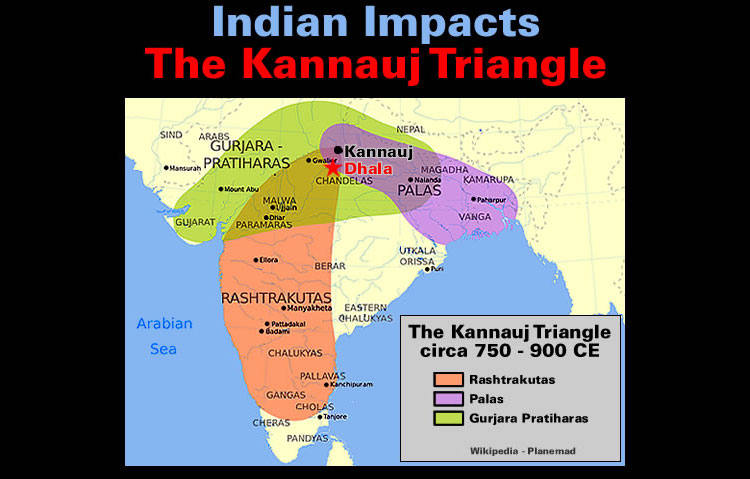
1.
888 Mihira Bhoja died.
2.
985 Accession of Rajaraja I Chola-South India.
3.
997 Abu-l-Qasim Mahmud captured Ghazni.
Kulapati K M
Munshi wrote in foreword, “It was the age of Kanauj or Kanyakubja, which dominated Madhyadesa, the heartland of India. Eventually it passed into hands of the Pratihara Gurjararesvaras about 815, remained the metropolis of power till 950 and continued to be the most influential centre of culture till 1018 when it was destroyed by Mahmud of Ghazni.”
“In 712 the Arabs conquered Sindh. About 725 its governor Junaid overran Saurashtra, Abu region and reached Ujjain. An unknown hero Nagabhata rose.@ He rallied clans who had their home in the region of Mount Abu and destroyed the invading enemy. The Arabs were driven out of Kutch between 833-842. A few years later they lost the best part of Sindh. Two petty principalities remained to the Arabs of which Multan and al-Mansurah were capitals.” @Along-with Bappa Rawal of the Guhila dynasty of Mewar.
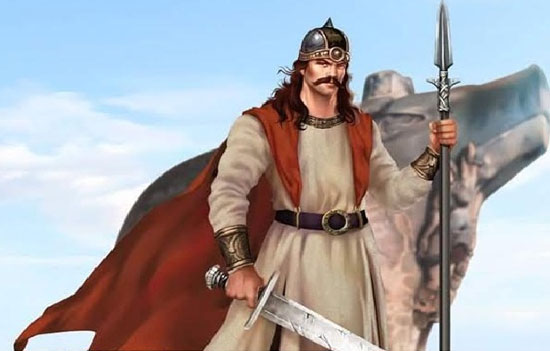 Mihir Bhoja.
Mihir Bhoja.
“Arab visitors praised Mihira Bhoja. The last known date is 882. At the time of his death, the banner of Ikshvaku Gurjaresvaras flew over an empire larger than those of the Guptas and Sri Harsha (it comprised north India from the Himalayas to a little beyond the Narmada, from East Punjab and Sindh to Bengal). The Arabs on the north-west frontier were kept at bay; Sindh had been wrested from them.”
“In 997 A.D.Abu-l-Qasim Mahmud captured Ghazni, developed a marvellous striking power and turned his attention to India.”
Indians should be aware what is happening in the neighbourhood and effect on its security.
3. Period 1000 to 1300 (Bhavan
volume 5)
This part covers invasions of Mahmud of Ghazni/Ghori, their impact & Khilji’s.
1.
1005-06 Mahmud expedition against Multan, 1011 plundered Thaneswar.
2.
1018 Mahmud marched to Mathura & Kanauj (near Kanpur).
3.
1018 Rajendra Chola conquered Ceylon.
4. 1025 Mahmud plundered Somnath Mandir. Fragments of Siva-linga carried to Ghazni where they became steps at the gate of the Jami Mosque. Destruction of the Shahi kingdom of Afghanistan & its inclusion along with Punjab in the kingdom of Ghazni made the Islamic conquest of India an easier process.
5.
1033 Battle
of Bahraich (in modern day Uttar Pradesh).
- Ghazni’s nephew Masud was defeated by Raja Suheldev lead warriors. Next major invasion 1178.
6.
1178 M Ghori attacked Gujarat.
- He
was defeated by Chalukya Mularaja II at Kasahrada at the foot of Mt Abu.
7.
1190-92 1st and 2nd Battle of Tarain i.e. Prithviraj
Chauhan vs. M Ghori.
8.
1193 Qutub-ud-din Aibak (governor of Ghori) captured Ajmer, made Delhi capital.
9.
About 1200 Bakthtyar Khilji raided Bihar, Bengal but failed in Assam/Tibet.
10.
1233 Iltutmish (son-in-law & successor of Aibak) plundered Ujjain &
conquered Bhilsa. He died in 1236.
11.
1294 Alauddin Khilji invaded Devagiri (near Aurangabad).
12.
1303 Khilji marched into Chittor and 1305 into Malwa.
13.
1338 Kashmir came under Muslim rule (starting with Shams-ud-din)
Kulapati K M
Munshi wrote in foreword, “The most crucial age in Indian history began in 998 A.D., when the Turkish Mahmud captured Ghazni. It ended in 1292, when the Khalji Chief, Jalal-ud-din, proclaimed himself the Sultan of Delhi. It can be divided into 2 periods, the first ending in 1193, when Ghori defeated Prithviraj Chahamana of Ajmer, the second ending in 1299.”
“War being a special privilege of the martial classes, harassment of the civilian population during military operations was considered a serious violation of the code of honor. The high regard the Kshatriyas had for the chastity of women, also ruled out their abduction as an incident of war. The wars in Central Asia, on the other hand, were grim struggles for survival, destruction of their enemies and appropriating their womenfolk. No code existed.”
“Mahmud annexed Punjab, thereby opening the way to the hungry men from the steppes of Central Asia to descend upon this rich and fertile land in search of plunder. In a few years, Thaneswar, Mathura, Kanauj and Prabhasa Pattana were smoking ruins. The raids of the Turks were, halted in the
east by Vidyadhara Chandella at Kalanjara @and in the south-west, where Mahmud had to beat a hasty retreat for fear of the federated armies of ‘Paramdeva’, whom I would identify with Bhoja Paramara of Dhara (1000-1055).” @in 1019 & 1022.
“The destruction and humiliation inflicted by Mahmud’s raids shocked India’s sense of superiority, bringing into play several political, social and psychological factors. With the Yaminis, successors of Mahmud, firmly established in Punjab, the Aryavarta-consciousness lost whatever significance it had.”
“When Ghori invaded in 1175 the impact was borne by 3 powerful princess i.e. Prithiviraj of Ajmer, Jayachandra Gahadavala of Kannauj and Mularaja II Chalukya of Gujarat. Mularaja drove him back in 1178, Chauhan in 1191, but no two of them would combine. When Chauhan lost in 1192 and Jayachandra died fighting, the Turkish cavalry swept over the plains of the Ganga. In 1206, Qutb-ud-din Aibak established the Turkish Sultanate at Lahore, later moved to Delhi.”
“About the middle of the 13th century, the Mongols established themselves in Afghanistan. So retreat to their homeland was now cut-off for the Turks. This compelled them to make India as their permanent home.”
“However, inspite of military operations for over a century, the
core of the Sultanate comprised only of the central military base of Delhi and
surrounding districts within a radius of about 250 miles of it. The
frontier posts were no better than garrison posts from which the Turkish
satraps carried on raids against Indian chiefs, who held the rural areas. From
the Indian point of view, therefore, the territory of the Sultanate in the 13th century was only an area of resistance which neither wavered nor tired.”
“From 1192 A.D. when Chauhan lost the battle of Tarain, till 1301 when his descendant, the heroic Hammiradeva, fell in the battle field, they defied the Sultanate year after year. And so did the Katehrs.”
“Except within areas in which Turkish armies operated, the India of the age belonged to the heroes of resistance. Outside this area lay
large parts of North India and the whole of the South-in fact 3/4th
of the country where India followed its unbroken way of life and Hinduism flourished unobstructed.”
Clearly, Invaders did not rule all of India during 1000 to 1300.
“In North India, the areas of military resistance
were the old kingdoms of Dahala ruled by Kalachuris (11th century to
1212), Jejakabhukti ruled by the Chandelas (9th century to 1315),
Malwa ruled by the Pratiharas (10th century to 1305) and Gujarat
ruled by the Chalukyas and Vaghelas (940 to 1299). In the South the Western
Chalukyas (973-1189), the Yadavas (1185-1317), the Kakatiyas (1050-1322), the
Eastern Chalukyas (999-1271) and later Pandyas (11-14th centuries)
and Hoysalas (1106-1343) ruled flourishing kingdoms.”

Even before Bakhtyar’s disastrous defeat in Assam, Kalanjara was reconquered by the Chandellas. Pg. 130 During Iltutmish times (successor of Aibak) the extent of revival of Hindu Powers and the difficulties facing the Delhi troops were underlined by the inconclusive results of his operations in Rajputana. Pg. 134 Post Iltutmish death the Hindu forces of Orissa fought back and in Assam the Turks (Yuzbak) suffered an unparalleled setback, at the hands of hill tribes and Kamarupa forces. Pg. 145 Chandellas had effected a speedy recovery and by 1241 ruled over modern Rewa. Pg. 146
1033
Battle
of Bahraich (in modern day Uttar Pradesh). Ghazni’s nephew Masud was defeated by Raja Suheldev lead warriors. Next major Muslim invasion in North India took place about 1187 and was by M Ghori.
Effect of loss meant for nearly 150 years there were no Islamic
invasions.
In 1178 Ghori’s army was routed the by the king of Gujarat Chalukya Mularaja II at Kasahrada at the foothills of Mount Abu. Pg. 166
4. Period 1300 to 1526 (Bhavan volume 6)
This
part covers Ala-ud-din Khilji, M Bin Tughlaq and Maharana Kumbha.
1.
1294 Ala-ud-din Khilji invaded Devagiri (near Aurangabad) and wins.
2.
1301 Capture of Ranthambore by Khilji.
3.
1302-03 Capture of Chitor. Lost war in Warangal (Andhra). They were badly
defeated, forced to beat a hasty retreat. Khiljis could not retain Chitor for
long due to Rajput resistance. Khizr Khan abandoned it in 1311-12. Pg. 26
4.1307
Khilji established authority in Rajputana. He marched against Siwana, won. With
fall of Jalore all Rajput states brought under Khilji control.
5.
1308 Warangal expedition. Prataparudradeva submits and pays tribute. With this
the country of Tilang (undivided Andhra Pradesh) was conquered. Pg. 54
6.
1316 Death of Khilji, was the first great Muslim administrator in India. Pg. 40
7.
1323 Nasir-ud-din ascended throne in North Bengal. Bahram Khan appointed to
govern South and East Bengal. Pg. 194
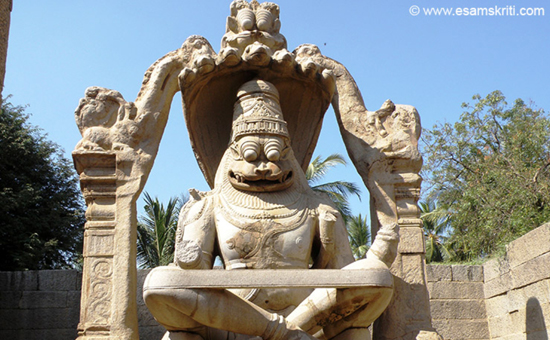 Lakshmi Narasimha,
Hampi.
Lakshmi Narasimha,
Hampi.
8.
1326 Per Rajput chronicles Rana Hamirdeva seized Chitor in 1326 and gradually
established his authority over whole of Mewar. Pg. 70
9.
1327 Capital transfer from Delhi to Daulatabad by M Bin Tughlaq.
10.
1327 Koli chief of Simhagarh Fort (Kondana) near Pune submits. Pg. 69
11.
1335 Revival of Hindu power in South India.
Also read All
about Vijayanagara Kings/Empire
12. 1336 Foundation of Vijayanagara. Accession of Harihara I (ruled 1336-56.)
- Hindu confederacy led by Prolaya Nayaka. Pg. 75 Kapaya Nayaka and Chalukya Somdeva contributed too. By 1328 M Bin Tughlaq succeeded in establishing his authority up to the southern extremity of Indian Peninsula. But in less than 10 years he lost the entire region to the south of the Krishna-Tungabhadra line, part of Telangana & coastal districts of Andhra. Pg.77
13.
1351 Death of M Bin Tughlaq.
14.
1356 A patent arrives from the Caliphate conferring the whole of Hindustan on
Firuz Shah (successor to Tughlaq).
- Firoz
destroyed the temple of Jagannatha at Puri and desecrated the images. Pg. 93
15.
1364 Death of Ahom king Sukrangpha and accession of Sutupha.
16.
1395 Muzaffar destroys the temple of Somanatha.
17.
1398 Timur plunders and devastates Delhi.
18.
1414 Ahmad of Gujarat appoints an officer to destroy Hindu temples in Gujarat.
19.
1439 Death of Ahom king Suphakpha and accession of Susenpha.
20. 1458 Maharana Kumbha again defeated Sultans of Malwa
& Gujarat.
21.
1469 Birth of Guru Nanak.
22. 1470 Bahmanis invade Vijayanagara – loss of Goa.
23.
1479 Birth of Vallabhacharya
24.
1488 Death of Ahom king Susenpha (reign 49 years), accession of Suhenpha.
 Vijaya Stambh, Chittorgarh Fort.
Vijaya Stambh, Chittorgarh Fort.
25.
1495 Muhammad recaptures Kashmir.
26.
1498 Vasco arrives in Calicut.
27.
Krishnadevaraya of Vijayanagara Empire ruled from 1509-1529.
28.
1510 Chaiyanya Mahaprabhu becomes a Sannyasin.
29.
1526 First Battle of Panipat. Babur defeats Ibrahim Lodhi.
30.
1527 rout of Muslim army invading Assam.
31.
1528 Death of Maharana Sangha.
32.
1565 Battle of Talikota between Vijayanagara King and Sultans of Deccan.
Dr R C Mazumdar
wrote
in foreword, “The popular notion that after the conquest of M Ghori, India formed a Muslim Empire under various dynasties is hardly borne out by facts. It was ‘Ala-ud-din Khilji who the first time established Muslim suzerainty over nearly the whole of India. But his actual sovereignty did not extend beyond the Vindhyas, save in the Western Deccan during the last three years of his rule.” Khilji ruled from 1296 to 1316 A.D.
“The Tughluqs who succeeded the Khiljis made an attempt to revive the empire and exercise sovereignty over it but failed. The empire of M bin Tughluq, which included the southernmost part of India as a province under his governor, broke up within a decade of his accession (1325), and before another decade the Turkish Empire passed away for ever.”
“Thus barring these 2 short-lived empires which lasted for less than 20 and 10 years, there was no Turkish Muslim empire. The
Delhi Sultanate continued in name but shorn of power and prestige, it was
reduced to a phantom by the Timur invasion at the end of the 14th century.” (1398 A.D.)
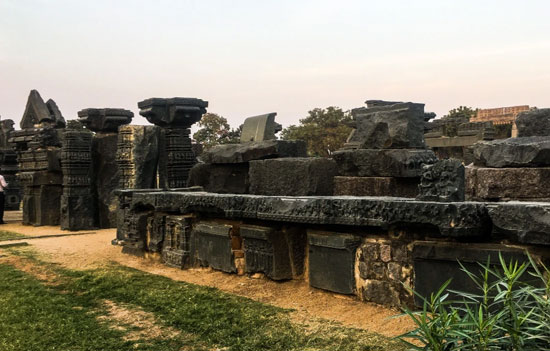 Temple, Warangal Fort was destroyed by army of M B Tughluq in 1323. Pic by Monidipa Bose.
Temple, Warangal Fort was destroyed by army of M B Tughluq in 1323. Pic by Monidipa Bose.
“Among the States that arose from the ruins of these two empires, 6 were really powerful. 3 ruled by Muslims i.e. Bahmanis of Deccan, Gujarat in the west and Bengal in the east. Vijaynagara in south India, Mewar in Rajputana and Orissa were ruled by Hindus. The remnants of the Sultanate and Muslim states of Jaunpur and Malwa, occasionally played an important role. Wars between these states weakened all powers. The Delhi Sultanate had a brief revival of power under the Lodis, and its quarrels with petty States in the north-west paved the way for the Mughal conquest under Babur.”
“So also the end of Hindu rule and destruction of temples and monasteries by Muslims, very nearly extinguished Hindu culture. India was saved from this disaster of complete destruction by the patronage of the rulers of Vijayanagara and Mithila.”
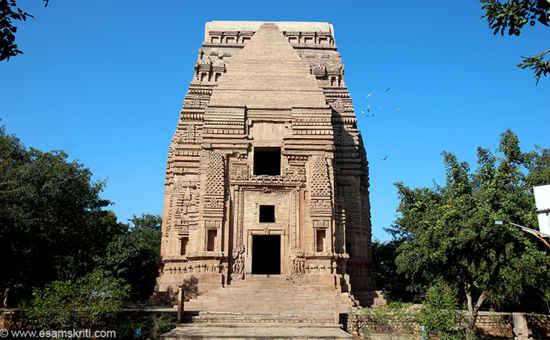 Teli-ka Mandir,
Gwalior Fort made by Pratihara king in
9th century.
Teli-ka Mandir,
Gwalior Fort made by Pratihara king in
9th century.
“Persecution of Chaitanya and his followers in the hands of the officers of Husain Shah must be remembered. Note that of the 24 years he remained in his mortal frame after he renounced the world, he hardly spent a year in dominion of Muslim rulers but lived for 20 years in the Hindu kingdom of Orissa.”
Invaders did not continuously rule over India for a long period.
5. Period 1526 to 1707 (Bhavan volume 7).
This
part covers Mughals (Babur to Aurangzeb), Shivaji and Rajputs.
1.
1026 Mahmud Ghazni raids India. 1192 P Chauhan defeated by M Ghori.
2.
1135-382 Lal Ded, Kashmiri poetess.
3.
1411-1442 Sultan Ahmed I of Gujarat.
4.
1487 Sankaradeva, who introduced Vaishnavism in Brahmaputra Valley, born.
5.
1490 Yusuf Adil Khan, of Bijapur proclaims independence.
6.
1490-1514 Maharaja Dhanyamanika of Tripura.
7.
1501 a throne less Babur is forced to retire to Tashkent.
8.
1504 Babur crosses Hindu Kush & captures Kabul from Muqim the Arghun
without any opposition. From Kabul he dreamt about the fertile plains of India.
9.
1509-1529 Krishnadevaraya, Vijayanagara emperor.
10.
1509-1553 Burhan Nizam Shah, Sultan of Ahmadnagar.
11.
1517-1526 Ibrahim Lodhi, Sultan of Delhi.
12.
1523 Birth of Gosvami Tulsidasa.
13.
1526 Babur defeats Ibrahim Lodhi in 1st
Battle of Panipat.
14.
1527 Babur sets out on his first jihad against Rana Sangram Simha. Battle of
Khanua in which Rajputs routed.
15.
1529 Battle of Gogra between Mughul & Bengal (defeated) armies. Babur
becomes master of North India. Negates last effort of Afghans to oust Mughals.
16.
1530 Humayun ascends throne.
17.
1530-1542 Acyutdevaraya, emperor Vijayanagara.
18.
1531 Rudra Pratap founds kingdom of Bundelkhand with Orchha
as capital.
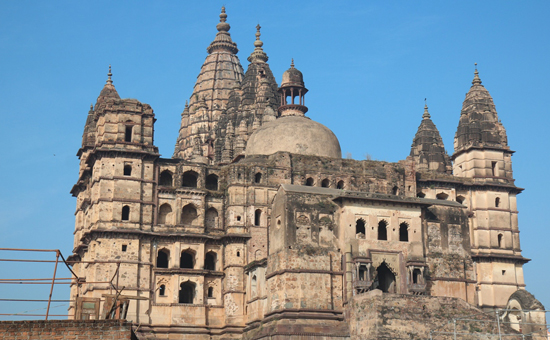 Chaturbhuj Mandir, Orchha.
Chaturbhuj Mandir, Orchha.
19.
1533-36 Sher Shah consolidates his position in Bihar & attacks Bengal.
20.
1535 Humayan captures Chittor.
21.
1538 Humayun captures Bengal.
22.
1540 Sher Shah defeats Humayan (returns to
Agra) in Battle of Ganga.
23.
1540-45 Humayan in Exile. Sought fortune in Sindh, Rajasthan, Persia.
24.
1540-1572 Uday Singh, Rana of Mewar.
25.1544
Sher Shah captures Chitor.
26.
1545 Sher Shah wounded in siege and dies.
27.
1545 Surdas compiles his Sur-saravali.
28.
1545 Mirza H, ruler of Kashmir accepts Mughal suzerainty.
29.
1552 St Francis Xavier passes away.
30. 1555-56 Humayan’s restoration on throne of Delhi as emperor.
31.
1556 Akbar ascends throne.
32.
1556 2nd Battle of Panipat-Himu vs. Mughal Army.
- Hemchandra
occupied Agra and Delhi before the battle. He was a Hindu.
33.
1557-1580 Adil Shah I of Bijapur.
34.
1562 Akbar &
Rajput alliances.
- The
Rajput alliance aimed to win the support of militant Hinduism, it was the start
of a new State-policy, the first being toleration. Pg. 113 (Ruling Hindu clans
and expand Mughal rule through them covertly).
35.
1562 Akbar army restores Mughal authority in Malwa.
36.
1564 Death of Rani
Durgavati at 40. She fell fighting against Akbar’s forces.
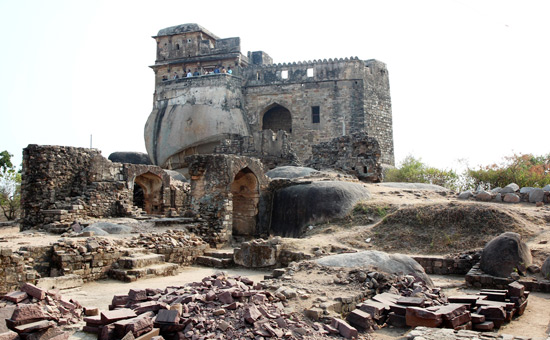 Rani Durgawati Mahal at Jabalpur.
Rani Durgawati Mahal at Jabalpur.
37.
1565 Battle of Talikota between Vijayanagara King and Sultans of Deccan.
38.
1568 Chitor falls to Akbar who orders massacre of 30,000 non-combatants. Pg.
334
39.
1572 Maharana Pratap Singh ascends Mewar throne.
40.
1573 Surat surrenders to Akbar. Akbar introduces reforms for e.g. conversion of
assignments (jagirs) into reserved
lands (khalisa).
41.
1575 Mughal Army captures Tanda, capital of Daud, Bengal.
42.
1576 Battle of Haldighati. Maharana Pratap vs. Mughal Army.
43.
1576 Vijayanagar army defeats Bijapur army at Chandragiri.
44.
1578 Mughuls capture Kumbalgarh in Mewar.
45.
1578 Madhukar Shah, the Bundela Chief, submits to Mughuls.
46.
1579 Akbar enters into a friendly alliance with Nara Narayan of Coonch Behar
(part of West Bengal). Also read About
Nara Narayan
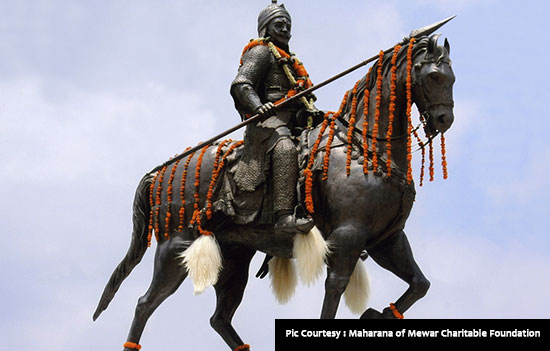 Maharana Pratap.
Maharana Pratap.
47.
1584 Maharana Pratap recaptured many of his lost territories.
- Through repeated war expeditions Akbar tried to capture or kill Pratap but failed. Before Pratap’s death all of Mewar except Ajmer, Chitor & Mandalgarh was in his hands.
48.
1585 Temple of Radha Vallabh constructed at Vridnavan.
49.
1586-1600 Rajadhara, ruler of Tripura.
50.
1587 Akbar transferred Raja Man Singh to Bihar.
- To
adopt a more vigorous policy against the Afghans and in Swat (modern day
Pakistan). Akbar wanted control over Kabul and Kandhar, the gateways to North
India.
51.
1590 Mughuls conquer kingdom of Afghan ruler in north-Orissa.
52.
1593 Mughuls conquer Orissa.
53.
1595 Akbar annexes Baluchistan.
54.
1595 Akbar completes conquest of north India excluding Assam.
55.
1599 Akbar leaves for Deccan with a mighty army, returns in 1601.
56.
1604-05 Tobacco, which was brought to India by the Portuguese introduced in Akbar’s court.
57.
1600-1632 Raghunatha Nayaka, ruler of Tanjore (TN).
- Court
had royal patrons of poets and poetesses.
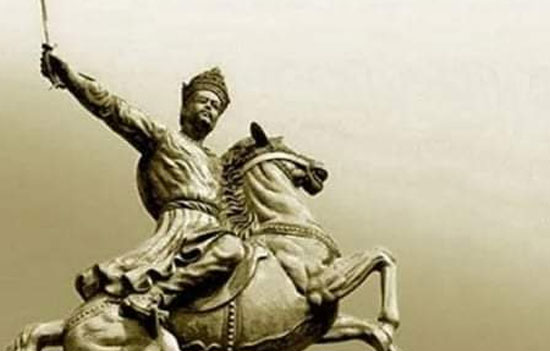 Nara Narayan of Koch dynasty.
Nara Narayan of Koch dynasty.
58.
1605 Jahangir ascends Mughal throne.
59. 1605 Jija Bai is married to Raje Shahji
Bhonsle.
60.
1609 Coonch Behar becomes a vassal kingdom of the Mughal Empire.
61.
1612 Mughuls subdue finally the Afghans in Bengal.
62.
1613 Mughuls capture Kamrup.
63.
1615 Mughuls send an unsuccessful expedition against Assam.
64.
1620 Kangra surrenders to Jahangir, military achievement.
65.
1623-1659 Tirumala Nayaka, ruler of Madura (in modern day Tamil Nadu).
66. 1627 Birth of Shivaji Raje.
67.
1628 Shah Jahan ascends throne.
68.
1635 Mughuls capture Orchha, capital of the Bundelas.
69.
1635 Mughul army subdues Garwhal, but meets with a heavy disaster.
70.
1636 Raje Shahji Bhonsle enters service of Bijapur Sultan as a general.
71.
1638 Peace treaty is concluded between Mughuls and the Ahom king.
72.
1646 Sriranga III, Vijayanagar ruler defeated by Mustafa Khan, the Bijapur
general, near Vellore. Signified end of Vijayanagar Empire.
73.
1649 The Nayaks of Tanjore submit to Bijapur Sultan.
74.
1654 Raja of Kumaon submits to Mughals.
75.
1657-59 Raj Singh, the Mewar Rana, wrests from the Mughuls, lost territories-four
districts. Pg. 346
76.
1658 Aurangzeb ascends throne.
77.
1658 Ahoms capture whole of Western Brahmaputra valley.
78.
1659 Bijapur army captures Tanjore (Thanjavur).
79.
1659-1682 Chikkanatha Nayaka, Ruler of Madurai.
80.
1662 Raja of Cooch Behar wrests his kingdom from Mughuls but submits in 1664.
81.
1665 Shivaji concludes peace with Mughuls at Purandar.
82.
1666 Shivaji escapes with his son Sambhaji
from Agra.
83.
1668 Shivaji concludes peace with Aurangzeb who confers the title of Raja on Shivaji.
84.
1669 Aurangzeb pulls down Kashi Vishwanath Mandir.
85.
1671 Battle of Salher where the Marathas defeat Mughal forces. Read Here
86.
1674 Shivaji Raje coronation at Raigarh as Chhatrapati or Sovereign King.
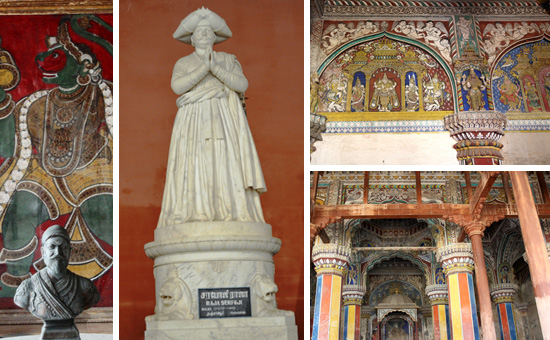 Maratha Palace, Tanjore.
Maratha Palace, Tanjore.
87.
1674-1687 Ekoji, ruler of Tanjore.
88.
1677 Shivaji concludes alliance with Golconda and conquers Gingee, Vellore and
parts of Mysore, Madras and Carnatic territories. Shivaji visited this temple
in Chennai. To see album
89.
1679 Aurangzeb annexes Marwar to his kingdom.
90.
1679 Mughuls recover Gauhati by bribery.
- Maharani
Tarabai played an important role in the 27 year battle between the Marathas and
Aurangzeb starting 1680. Read Here
91. 1681 Aurangzeb proceeds to Deccan after Shivaji’s death.
92.
1681-1707 Marwar asserts independence and fights Mughal imperialism.
93.
1687 Mughal army lays siege to Golconda.
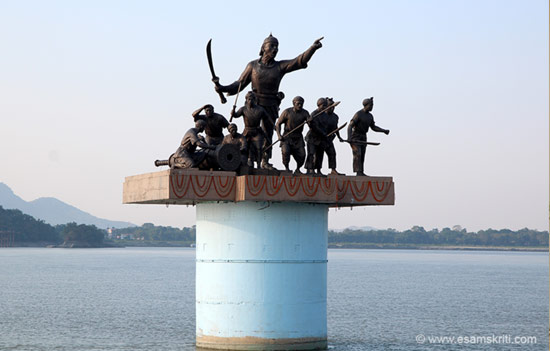 Memorial Lachit Borphukan, Guwahati who defeated Mughal Army in Battle
of Saraighati, 1671.
Memorial Lachit Borphukan, Guwahati who defeated Mughal Army in Battle
of Saraighati, 1671.
94.
1689 Chhatrapati Sambhaji captured and
killed by Mughals. Rajaram, his younger brother ascends throne.
95.
1689 Raigarh captured by Mughals, Shahu (son of Sambhaji) taken prisoner.
96.
1689 Rajaram, Maratha king reaches Gingee (Tamil Nadu).
97.
1695 Santaji, the Maratha general, defeats Mughal general Qasim Khan and puts
Mughal army to rout. To read all about Santaji
Ghorpade and battle
98.
1700 Satara falls to Aurangzeb.
99.
1704 Mughal Army besieges camp of Guru Govind Singh who escapes.
100.
1704 Aurangzeb concludes peace with Ajit Singh of Marwar.
101.
1706-1732 V Chokkanatha Nayaka, ruler of Madura. (in Tamil Nadu)
102.
1707 Aurangzeb dies at Ahmadnagar.
103.
1707 Ajit Singh captures Jodhpur.
104.
1707 Chhatra Sal of Bundelkhand resumes activities for establishment of an
independent kingdom after severing connections with the Mughals.
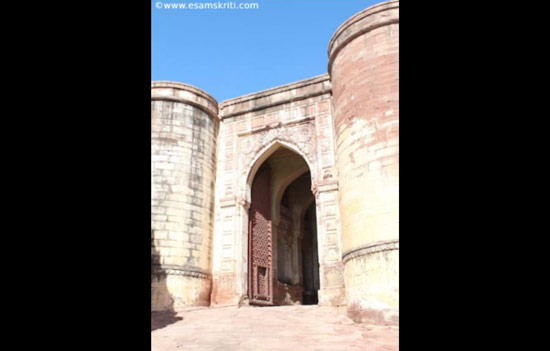 Fatehpol, Mehrangarh Fort, Jodhpur 1719. Built by Maharaja Ajit Singh to commemorate recapture of Marwar from Mughals in 1707.
Fatehpol, Mehrangarh Fort, Jodhpur 1719. Built by Maharaja Ajit Singh to commemorate recapture of Marwar from Mughals in 1707.
Author Saurabh
wrote
here, “The decline of the Mughal Empire started with Aurangzeb and for three reasons. One, religious bigotry. Two, unusually long reign. Three and often most neglected cause is the success of indigenous resistance, the most notable amongst them is the Maratha Empire.”
He adds, “So, within these five years, Mughal Empire lost parts of Maharashtra (to Marathas)-Malwa, and Bundelkhand to Maharaja Chhatrasal. With the restoration of Amber and Jodhpur to Maharaja Sawai Jai Singh and Ajit Singh by Bahadur Shah, the area actively controlled by the Mughal Kings shrank further.” Further, “By 1732 Mughals had to cede further ground to Chimaji Appa (younger brother of Bajirao) by giving rights to collect Chauth and Sardeshmukhi from all of Gujarat.” Also, “in 1751, the treaty was signed between Raghuji and Aliwardi, whereby Orissa was recognized as the part of Maratha Empire.”
The disintegration of the Mughal Empire began after the death of
Aurangzeb.
Dr R.C.
Majumdar wrote in Preface, “This is the period (1526-1707) during which Mughuls gradually established their authority over nearly whole of India.”
“Next to the Mughals, the Rajput States in the north, the five Sultanates of the Deccan arising out of the ruins of the Bahmani kingdom, and the Hindu Empire of Vijayanagara played a dominant role in history at the beginning of this period. (1527). The end of this period witnessed the rise of two great powers, the Marathas and Sikhs who were destined to play the most prominent role in the 18th century.”
“This volume may claim credit for rescuing from oblivion the name of Himu or Hemchandra, a forgotten Hindu hero who began his life as a greengrocer, and by dint of his own efforts and personality ascended the throne of Delhi-the only Hindu to do so after the Battle of Tarain in 1192 A.D.”
It can be said that the Mughuls ruled over India during 1556-1707
i.e. for a maximum 151 years.
6. Period 1707 to 1818 (Bhavan volume 8)
This
period is the Maratha century because of their domination over India.
 Marathas captured Attock in modern day Pakistan.
Marathas captured Attock in modern day Pakistan.
1.
1719 The new Mughal emperor, Rafi-ud-Darjat, ratifies the grant to Swaraj, Chauth and Sardeshmuki of the six
subhas of the Deccan to the Peshwa, agreed to in 1718.
2.
1728 Bajirao Peshwa defeats the Nizam at Palkhed.
3.
1730 Fort of Mandu (Malwa) captured by the Marathas (Holkar and Pawar) restored
to the subahdar as a result of
understanding between Chhatrapati Shahu and Mughal emperor.
4.
1730 Malharrao Holkar granted entire assignment of the subah of Malwa.
5. 1737 Peshwa’s commander, Pilaji
Jadhav, routs the Mughal army near Delhi.
6.
1739 Nadir Shah enters Delhi.
7.
1743 Nizam-ul-Mulk marches into Karnataka and ousts Marathas.
8.
1748 Ahad Shah Abdali, attacks India for the first time but attack repulsed.
9.
1751 Rajputs massacre the Marathas in Jaipur.
10.
1751 Orissa ceded to the Marathas (Raghuji Bhonsle) by Nawab A V Khan.
11.
1752 Mughal emperor enters into a treaty with the Marathas and entrusts them
with task of defending the empire and from internal and external aggressions.
12.
1753-60 Peshwa Balaji Rao conducts number of campaigns to establish Maratha
supremacy.
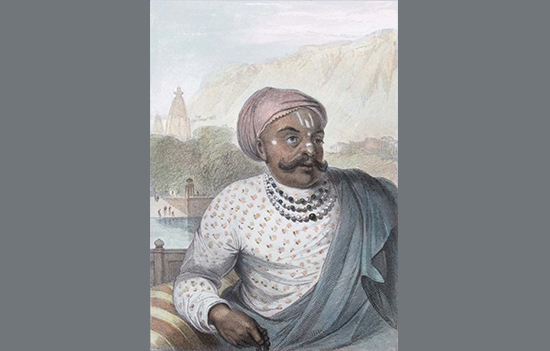 Warrior Mahadji Shinde, Gwalior (1730-1794) contributed to Maratha resurgence.
Warrior Mahadji Shinde, Gwalior (1730-1794) contributed to Maratha resurgence.
13.
1756 Jaipur and Jodhpur make peace treaty with the Marathas.
14.
1757 Raghunath Rao, Maratha general, attacks Delhi and captures it.
15.
1758 1st Maratha invasion of Punjab by Raghunath Rao assisted by M
Holkar.
16.
1758 Marathas under Tukoji Holkar march beyond Attock & reach Peshawar.
17.
1761 Marathas loose in the Third Battle of Panipat.
18.
1764 Abdali ratifies a formal peace with the Marathas.
19.
1766 The combined Jat-Sikh army defeats Marathas at Dholpur.
20.
1767 Peshwa Madhav Rao I marches into Karnataka and captures several forts held
by Haider Ali.
21.
1771 Mahadji Sindia captures Delhi and requests Shah Alam to return to his
capital.
22.
1784 Mahadji Sindia attains supreme power in Delhi.
23.
1803 Ranjit Singh enters into a defensive & offensive alliance with
British.
24.
1819 Ranjit Singh captures Kashmir.
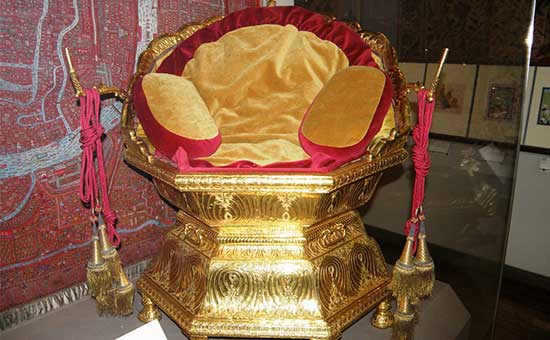 Maharaja Ranjit Singh throne.
Maharaja Ranjit Singh throne.
Dr R.C. Majumdar
wrote in Preface, “This period covers the history of India from the death of Aurangzeb (1707) to the Third Maratha War (1818). It witnessed the end of Muslim rule, the rise and fall of the Maratha Empire and the foundation of the British Empire in India.”
The 18 century is considered to be the Maratha Century because the Marathas dominated India. Here are links to a series of articles for further reading –
1.
How
the Marathas contributed to the decline of Mughal Rule in India Part 1
2.
How
the Marathas contributed to the decline of Mughal Rule in India Part 2
3.
The
Maratha Century
4.
Battle
of Assaye 1803 between Marathas and British
5. The story of Thanjavur’s Maratha Kings
6. Maratha
Palace Thanjavur Tamil Nadu album
7. Bajirao Peshwa – The Empire Builder
8. Life
story of Mahadji Scindia
9. Malhar Rao Holkar – Subedar of Malwa
10. Debunking
myths about Prithviraj Chauhan
11. Madhav
Rao Peshwa the Great
Wonder why Indians give so much importance to history post 1000 A.D.?
This 800 years of Muslims ruling India is a myth!
Also read
1. Guru
Nanak on Babur invasion
2. Kanhoji Angre was India’s first Naval commander
3. About Maharaja Ranjit Singh – The Lion of Punjab
 Ahilyabai Holkar Fort & Cenotaph Complex, Maheshwar.
Ahilyabai Holkar Fort & Cenotaph Complex, Maheshwar.
The above excerpts
are courtesy and copyright the publisher the Bharatiya Vidya Bhavan, Kulapati K.M.
Munshi Marg, Mumbai-400007.
Cover pic credit mapsofindia.com. All other pictures credit www.esamskriti.com except where stated. No part of this
essay should be reproduced without specific permission of www.esamskriti.com